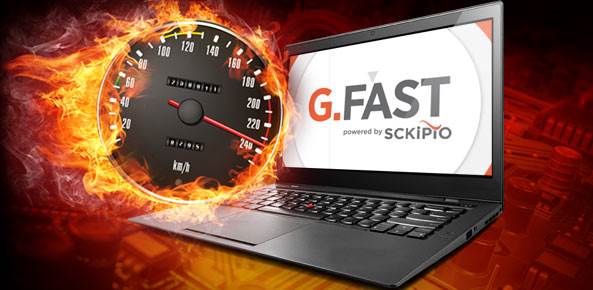Currently, Google Fiber is the only option for users who want Internet speeds that outpace both cable and DSL. But because of the time it takes to install fiber-optic lines and deal with other infrastructure matters, Google Fiber is available in only a handful of metropolitan areas.
However, one company is aiming to provide a viable high-speed Internet option for more people in less time. G.Fast is technology that will bring Google Fiber-like speeds to users via their phone lines.
Israeli chipmaker Sckipio is demonstrating the G.Fast technology at CES 2016 in Las Vegas this week, saying it trumps both expensive cable Internet and slow DSL service. In a demonstration for media members, the company displayed download speeds of nearly 750 megabits per second by way of a regular phone line — a speed of about 50 times what the average home broadband services currently offer.
Existing Wires
The G.Fast service uses the copper wires that already exist in many homes, apartment buildings and other structures to offer more service options and greater speed. The company said that it plans to work with Internet service providers to deliver fiber-like speeds for less money, ideally leading to greater competition between ISPs and thus lower costs for consumers. Because it uses existing copper phone wiring, telco providers don’t have to install as much equipment to enable gigabit-level services.
Sckipio is banking on the growing trend of so-called gigabit cities — areas that can accommodate and offer broadband Internet speeds of one gigabit per second. The trend is being pushed by a growing number of bandwidth-hungry applications — such as video, big data and cloud storage — that are putting ever-increasing pressure on service providers to keep up. Bringing gigabit speeds the so-called “last mile” into homes is a daunting task for ISPs, considering deployment costs and right-of-way access issues.
And that demand only continues to grow — some studies have projected that global IP traffic will surpass the zettabyte (1,000 terabytes cubed) threshold in 2016, and the two-zettabyte threshold in 2019. That means service providers that can’t keep up will be left behind.
Viable Method
A number of factors make G.Fast the best solution for service providers, Sckipio said. Those include simplicity of deployment, low capital outlay of its idea, and a faster way to deploy fiber service with a minimum of disruption.
Alcatel-Lucent and Taiwanese telecom operator Chunghwa Telecom plan the first commercial deployments of G.fast households and businesses across Taiwan. A number of homes in Swansea, Wales, have already participated in trials of the technology. Sckipio said the G.Fast technology will debut in the United States later this year.
“One of the issues is that you need more bandwidth and there’s only a few ways we can deliver 4K effectively with the bandwidth needed,” Kevin Foster, chair of the Broadband Forum, told CES attendees today. “G.Fast, therefore, is a viable way of getting technologies out there quickly and effectively.”







